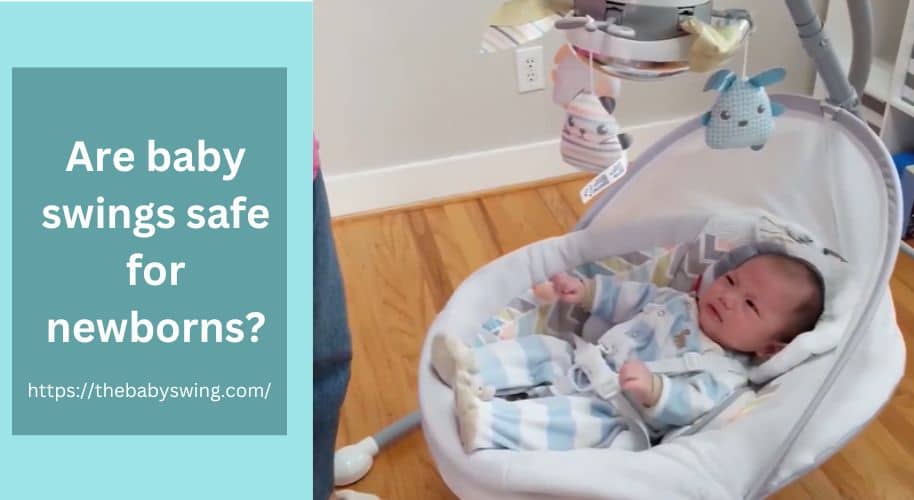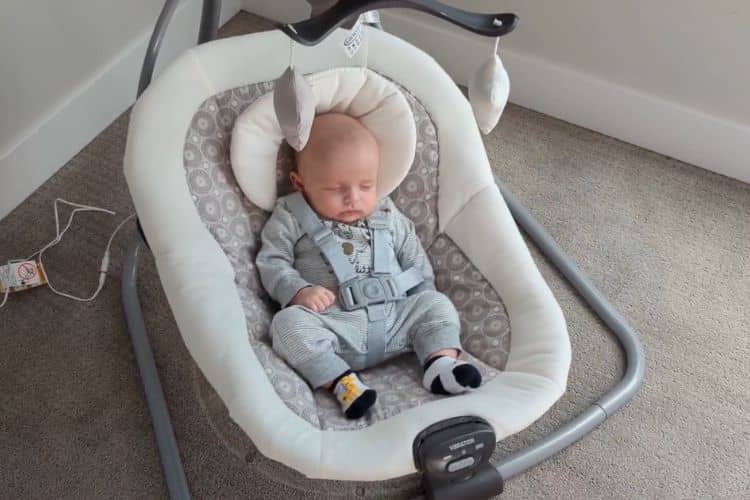Last Updated on July 20, 2023
When it comes to newborns, baby swings can be a great way to soothe and entertain your little one. However, you must take safety precautions when using a baby swing. The American Academy of Pediatrics recommends that babies should not be left unattended in a baby swing and should never sleep in them.
In this article, we’ll discuss the safety precautions you should take when using a baby swing with your newborn and how to choose a safe one. So, keep reading!

- Are baby swings safe for newborns?
- Watch this video on newborns sleeping in a bouncy seat or swing at night
- Do baby swings cause brain damage?
- Are baby swings bad for development?
- Potential risks of babies sleeping in swings
- How many hours can a newborn safely spend in a swing?
- Can baby sleep in swing supervised?
- How to Safely Use a Baby Swing?
- What are the benefits of using a baby swing?
- Wrapping Up
Are baby swings safe for newborns?
Parents are often concerned about the safety of baby swings when it comes to newborns. The good news is that baby swings can be a safe and comfortable option for your newborn as long as you take certain precautions.
Before using a baby swing, make sure to read the manufacturer’s instructions carefully. All baby swings should meet safety standards set by organizations such as the Juvenile Products Manufacturers Association (JPMA).
Additionally, check for recalls by the Consumer Product Safety Commission (CPSC). You should also avoid any second-hand swings or swings that have been given to you by someone else for safety reasons.
When using a baby swing with your newborn, be sure to always stay within arm’s reach and never leave them unattended.
Additionally, make sure the straps are securely fastened and the seat is in the most reclined position. It will help ensure your baby is safe and comfortable in the swing.
Make sure to use the lowest speed setting on the swing. And never let your baby sleep in a baby swing, as it can increase the risk of suffocation or strangulation.
We spoke to Dr. Alisa Baer, a board-certified pediatrician, and nationally certified child passenger safety instructor.
She said, “Make sure the product is age-appropriate and is being used as directed. However, it’s best to use swing when your baby is 4 months old or above. By this time, their neck muscles are strong enough to hold them in an upright position and they are more aware of their surroundings.”
“However, if you decide to use a baby swing for your newborn, you must use the safety harness provided with your baby swing every time you place them in it. This will help ensure that your baby does not slide out of the seat,” she added.
Dr. Alisa emphasized, “Never allow newborn to sleep in any type of swing, as it can pose a suffocation risk which can lead to SIDS.”
According to the American Academy of Pediatrics, infants are at an increased risk for injury or worse when placed in a bouncy seat, baby swing, or carrier to sleep during their first year. This rule applies both for naps and nighttime sleep.
So, if you decide to use a baby swing with your newborn, always take extra precautions and safety measures. Never leave them unattended; make sure they are securely strapped in and use the lowest speed setting.
Also read: How to get baby to sleep without swing
Watch this video on newborns sleeping in a bouncy seat or swing at night
Do baby swings cause brain damage?
No, baby swings do not cause Shaken Baby Syndrome or brain damage, as their motion is not forceful enough to inflict harm.
The American Academy of Pediatrics has stated that baby swings are safe for children when used properly and monitored closely.
However, electric baby swings should be used with caution, as they can disrupt a child’s sleep and cause overstimulation.
“Swinging your baby for an hour or more can become overstimulating. That’s why, you should limit the time your baby spends in the swing to 30 minutes at a time, 1 hour in total,” said Dr. Alisa.
She also suggested monitoring your baby’s reactions to make sure they are not getting overly stimulated or fussy.
So, while baby swings can be a safe and comfortable option for your newborn, you should use them cautiously and ensure you follow all safety guidelines.
Dr. Alisa also emphasized that any type of shaking or jerking can be dangerous for babies and should be avoided at all costs.
So, parents should always take precautions when using any type of baby swing or bouncer to ensure their safety and well-being.
Are baby swings bad for development?
As stated before, baby swings can be a great way to soothe and entertain your baby, but parents should use them safely and in moderation. While there is no evidence that baby swings are bad for development, overuse of swings can lead to physical and developmental delays.
When used properly, baby swings provide a safe environment for your infant to relax and explore their surroundings.
The gentle rocking motion helps stimulate the vestibular system, which is responsible for balance and coordination. This stimulation helps with motor skills and sensory integration.
Additionally, the swinging motion can help calm a fussy baby or give them an opportunity to practice their neck muscles.
However, if your baby spends too much time in a swing, they may not get enough tummy time or other activities that promote healthy development.
Too much time in a swing can also cause flat spots on the back of their head due to extended periods of lying down in one position.
That’s why it’s essential to limit the amount of time your baby spends in the swing each day and make sure they get plenty of tummy time as well as supervised playtime on their own.
Overall, baby swings can be beneficial when used correctly and in moderation. But make sure you follow all safety guidelines when using a swing, and don’t forget about other activities to help your child reach developmental milestones.
Also read: Baby Swing vs Bouncer: Which One’s Right For You?
Potential risks of babies sleeping in swings

Unsafe Position
Babies should not be placed in swings that recline more than a 45-degree angle and their faces should always remain visible above the edge of the swing.
Suffocation Hazard
The baby’s head might slump forward, which can obstruct the airway and cause suffocation. In addition, soft blankets, stuffed animals, or other items should never be placed in a swing with a baby as these can cause the baby to suffocate.
Risk of Strangulation
Loose or broken straps on a baby swing can cause strangulation if they become wrapped around your baby’s neck.
Developmental Issues
Babies should not be placed in swings for more than 30 minutes at a time as it can interfere with their physical and developmental growth, as well as lead to flat head syndrome (plagiocephaly).
Overheating
Baby swings are usually enclosed spaces that can trap body heat, raising the temperature of your baby’s environment. This increases the risk of overheating, leading to dehydration and possibly SIDS. You should make sure the swing is properly ventilated, and you dress your baby appropriately when using a baby swing.
Abnormal Motor Skill Development
If babies spend too much time in a stationary baby swing, it can delay their motor development as well as their ability to roll over, scoot, crawl and walk. Therefore, parents should encourage physical activity in between swing sessions.
Risk of Falling
Baby swings can tip over if your baby twists or turns too much while inside the swing. To prevent this from happening, make sure the swing is placed on a flat surface and never leave your child unattended in the swing. Regularly check for any signs of wear and tear that could cause the swing to be unstable.
Also read: How to store a baby swing
How many hours can a newborn safely spend in a swing?
According to the American Academy of Pediatrics, babies younger than 4 months should not be left in a motorized swing for more than 30 minutes at a time or an hour total per day.
This is because prolonged use of a baby swing can increase the risk of positional asphyxia and SIDS.
Parents should also ensure that the baby swing is sturdy and doesn’t tip over or fold up unexpectedly.
Additionally, always use the most reclined position on the swing for babies four months and under.
Can baby sleep in swing supervised?
It is not recommended to let your baby sleep in a swing, even if they are supervised. According to the American Academy of Pediatrics (AAP), swings are not designed for babies to sleep in and can be dangerous.
We’ve already mentioned that babies have not yet developed the muscles necessary to maintain their airways while sleeping in a swing, which can lead to suffocation or other serious health risks.
If your baby does fall asleep in the swing, move them into a safe sleeping environment as soon as possible.
If you need to use the swing for short periods of time during the day, make sure that your baby is strapped in securely and that you are always present and supervising them.
How to Safely Use a Baby Swing?
When using a baby swing, you should follow some basic safety guidelines:
1. Place the baby swing on a flat, level surface.
2. Ensure all harness straps are securely fastened and snugly fit the baby.
3. Don’t leave your baby unattended in the swing for long periods of time.
4. Be aware of any dangling cords that may pose a strangulation hazard for your baby.
5. Use only with children who can hold their heads up and sit upright unassisted.
6. Always follow the manufacturer’s instructions for the use and assembly of the swing correctly and consistently check all parts before use to ensure they are secure and working properly.
7. Make sure not to exceed weight limits as noted by the manufacturer – usually 25-30 pounds.
8. Place the swing away from walls and furniture to avoid potential harm to your baby if he/she suddenly pushes off of the back wall or side of the swing.
9. Don’t hang toys or other hanging items on the baby swing – this can create a strangulation hazard for your baby.
10. Check regularly for wear and tear, including checking all screws, nuts, bolts and moving parts are tight before each use.
11. Dispose of the swing when it becomes worn out or damaged in any way, as it may no longer be safe for use by your child or future child occupants.
12. Do not add extra padding to the seat, as this can cause the seating area to become too soft and can cause your baby to slip down or have difficulty breathing.
13. Place the swing in an area away from potential hazards such as windows, heaters, and fans to avoid any potential danger to your child.
14. If you are using a battery-operated swing, make sure to follow the manufacturer’s guidelines for replacing batteries and check regularly that they are in good working condition.
15. Refrain from pushing or rocking the swing with excessive force; this could result in injury or collapse of the swing due to instability.
16. Always supervise children when using a baby swing.
What are the benefits of using a baby swing?
Using a baby swing can provide many benefits to babies and parents. The benefits are:
– Helps to soothe babies and put them to sleep.
– Gives parents time to take a break and get some rest
– Stimulates the senses and improves development
– Promotes balance and physical coordination
– Provides sensory stimulation through motion, sight, sound, and touch
– Allows babies to be in an upright position which can help with digestion and reduce reflux symptoms
– Increases circulation of blood flow throughout the body
– Enhances motor skills by teaching a baby how to move their arms and legs independently
– Improves cognitive abilities by helping the brain develop more quickly
– Lowers stress levels for both parents and babies alike!
Wrapping Up
Thanks for reading this guide on baby swing safety for newborns. Remember, always use the lowest speed setting and never let your baby sleep in a baby swing.
Make sure to always stay within arm’s reach of your infant when they are in their swing, and fasten the straps securely before placing them in it.
Additionally, look for swings that meet safety standards set by organizations such as JPMA, and check for any recalls from the CPSC.
Taking these precautions will help keep your little one safe and comfortable while enjoying their baby swing.
Hope this article was useful and informative. Please feel free to comment or reach out to us with any questions or concerns. We’re always here to help.
Sources:
- https://www.todaysparent.com/baby/baby-sleeping-in-swing/
- https://www.verywellfamily.com/can-babies-sleep-in-a-baby
- https://www.verywellfamily.com/are-baby-swings-safe-5090557
- https://reviewed.usatoday.com/parenting/features/are-baby-swings-safe
- https://publications.aap.org/aapnews/article/34/1/25/24388/Safe-and-sound-tips-for-using-infant-swings
Sharing Is Caring!

Amy A. Vincent is a Certified Pediatric Sleep Consultant and a mother of three beautiful children. She helps parents transition their babies from swing sleep to safe, independent sleep. She is passionate about helping parents teach their children the skills needed to become good sleepers and aims to make the process as easy and stress-free as possible. Read more
